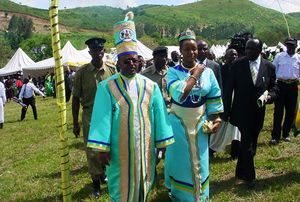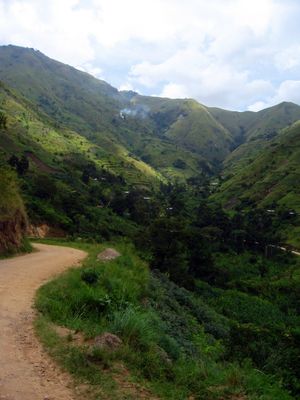روِنزورورو
مملكة روِنزورورو Obusinga Bwa Rwenzururu | |||||||||
|---|---|---|---|---|---|---|---|---|---|
| 1963–1982 | |||||||||
 العلم | |||||||||
 | |||||||||
| المكانة | مملكة | ||||||||
| العاصمة | كاسىسى | ||||||||
| اللغات الشائعة | الإنگليزية كونزو | ||||||||
| الحكومة | ملكية | ||||||||
| ملك روِنزورورو | |||||||||
• 1963–1966 | Isaya Mukirania | ||||||||
• 1966–1982 2009–الحاضر | تشارلز مامبرى | ||||||||
| الحقبة التاريخية | Cold War | ||||||||
• تأسست | 30 June 1963 | ||||||||
• انحلت | 13 August 1982 | ||||||||
| |||||||||
روِنزورورو Rwenzururu هي منطقة في جبال روِنزوري في أوغندا على الحدود مع جمهورية الكونغو الديمقراطية، كما أنها اسم حركة مسلحة تاريخية لتحقيق الاستقلال الذاتي أو السيادة لتلك المنطقة. كما أنه اسم مملكة أُعلنت في تلك المنطقة. وتضم مقاطعات بونديبوگيو وكاسىسى و نتوروكو.
خلفية
منطقة روِنزورورو تسكنها شعوب الكونجو وأمبا. In the early 20th century, these two tribes were integrated into the مملكة تورو as a political maneuver by the British colonialists: the neighboring Bunyoro monarchy was anti-colonialist (see 1907 Nyangire rebellion) and the British wished to strengthen the pro-British Toro. The Bakonjo and Baamba initially accepted being arbitrarily made subjects of the Toro monarch with resignation, but asked the محمية أوغندا to provide them their own district in the 1950s, separate from the Toro District.[1] The movement declared that they were not part of the Toro Kingdom on 30 June 1962, three months before national independence.[2]
النزاع والمملكة
After their request was denied by the colonial authorities, the Bakonjo and Baamba launched a low-intensity guerrilla war that continued through independence. The movement carrying out the armed struggle was named "Rwenzururu".[1] While the movement began to achieve recognition as a separate district, it eventually became a movement to secede and form their own kingdom.[3] The movement declared an independent Kingdom of Rwenzururu on 30 June 1962, three months before national independence, with Isaya Mukirania as king.[2][4] The violence reached a height in 1963 and 1964, when Toro soldiers massacred many Konjo and Amba people as they sought to control the lower valleys. The Ugandan army intervened against the separatists, doing such significant damage to the Rwenzururu that the movement was suppressed for some time.[3] The movement, however, achieved fame through a local folk epic.[5]
The Rwenzururu gradually re-established itself in the collapse of the regime of Idi Amin in 1979. As government soldiers retreated in the Uganda-Tanzania War, the Rwenzururu looted the weapons and supplies left behind. Thus well-armed, the Rwenzururu was once again able to pose a serious threat to regional control from 1979 to 1982. إلا أنه في 1982، توصلت ادارة الرئيس ملتون أوبوتى إلى تسوية مع زعماء روِنزورورو وفيها اتفقوا على التخلي عن هدف الانفصال مقابل "درجة من الحكم الذاتي"، the appointment of Bakonjo and Baamba to government administrative posts, and economic benefits such as vehicles and educational scholarships to be distributed by local elders.[6] During the negotiations, the government preferred direct talks, as they believed third-party mediation would give legitimacy to the Rwenzururu claim.[7]
Amon Bazira had been a key person in the negotiations between the Rwenzururu and Obote government. His insight was that the Rwenzururu was a largely middle class organization that could be placated with commercial prizes. He later approached President Mobutu Sese Seko of Zaire and President Daniel arap Moi of Kenya, who both had grounds for disliking the new Ugandan government led by Yoweri Museveni, for support for new Bakonjo rebellion under an organization called the National Army for the Liberation of Uganda (NALU). Bazira was shot dead in the State House in Nakuru, Kenya in 1993, a probable target of Ugandan agents.[8] In 1995, Sudanese agents engineered the merging of the remnants of NALU with the Uganda Muslim Liberation Army and the Baganda monarchist Allied Democratic Movement in order to give these latter organizations a local constituency, creating the Allied Democratic Forces.[9]
اعتراف حكومة أوغندا بها

وجد إحصاء أجرته جامعة ماكريرى أن 87% من السكان المحليين في روِنزورورو يحبذون خلق مملكة.[10] وفي 2005، أمر الرئيس موسڤني لجنة وزارية برئاسة النائبة الثاني لرئيس الوزراء ووزير الخدمة العامة هنري كاجورا أن يستقصي مطالبة روِنزورورو بمملكة وأن يصدر تقريراً باكتشافات اللجنة. The report stated that over 80 percent of the Bakonjo and Baamba favored the creation of a kingdom with Charles Mumbere as the Omusinga (king).[11] It further found that there is no historical claim for a مملكة روِنزورورو or a group of people called Banyarwenzururu, but recommended that the government bow to the wishes of the people.[12] Pursuant to these recommendations, on 17 March 2008 the Ugandan cabinet endorsed the Kingdom of Rwenzururu as a cultural institution.[11] Three contenders for the throne criticized the government's recognition of Mumbere as Omusinga.[13]
الهامش
- ^ أ ب Prunier, 82
- ^ أ ب "Our History", rwenzururu.com (accessed 6 June 2009)
- ^ أ ب Rothchild, 90
- ^ "Rwenzururu Kingdom wants Isaya Mukirania declare hero". Ugpulse (Ultimate Media). 5 September 2011.
- ^ Prunier, 82-83. See Kirsten Alnaes, "Songs of the Rwenzururu Rebellion," in P.H. Gulliver, ed., Tradition and Transition in East Africa (London: Routledge and Kegan Paul, 1969), 243-272.
- ^ Forrest, 222
- ^ Rothchild, 91
- ^ Prunier, 83
- ^ Prunier, 87
- ^ "Uganda: Welcome Rwenzururu", editorial by the New Vision, 31 March 2008
- ^ أ ب "Cabinet recognises Obusinga Bwa Rwenzururu", Ugee! Uganda Online, 31 March 2008 (accessed 6 June 2009)
- ^ "Uganda: Rwenzururu Kingdom Has Never Existed" by Caleb Mukirane, opinion in New Vision, 3 October 2007 (accessed 6 June 2009)
- ^ "Bakonzo contestants attack govt over Mumbere’s kingship" by Ephraim Kasozi & Joseph Miti, The Monitor, April 7, 2008 (accessed 6 June 2009)
- Forrest, Joshua (2004). Subnationalism in Africa: ethnicity, alliances, and politics. Lynne Rienner Publishers. ISBN 978-1-58826-227-1. Retrieved 6 June 2009.
- Prunier, Gérard (2009). Africa's World War: Congo, the Rwandan Genocide, and the Making of a Continental Catastrophe. Oxford: Oxford University Press. ISBN 978-0-19-537420-9.
- Rothchild, Donald S. (1997). Managing ethnic conflict in Africa: pressures and incentives for cooperation. Brookings Institution Press. ISBN 978-0-8157-7593-5. Retrieved 6 June 2009.
{{cite book}}: Cite has empty unknown parameter:|coauthors=(help)
للاستزادة
- Arthur Syahuku-Muhindo, "The Rwenzururu Movement and the Democratic Struggle," in M. Mamdani and J. Oloka-Onyango, eds., Uganda: Studies in Living Conditions, Popular Movements and Constitutionalism (Vienna: JEP Books, 1994), p. 273-317.
- Kambere, Amos Mubunga (2010). Celebrating literacy in the Rwenzori region : lest we forget : a biographical narrative of Uganda’s youngest member of parliament, 1980-1985. Victoria: Trafford. ISBN 978-1-4269-3098-0.
- Stacey, Tom (2003). Tribe: The Hidden History of the Mountains of the Moon. Stacey International. ISBN 1-900988-76-3.
وصلات خارجية
- Official Rwenzururu region website
- allafrica.com: "Uganda: Rwenzururu Wants Recognition — Mumbere" — New Vision, 26 September 2007.
- جمهورية ييري
